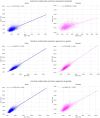Cycling is the most important predictive split discipline in professional Ironman® 70.3 triathletes
- PMID: 38390230
- PMCID: PMC10881807
- DOI: 10.3389/fspor.2024.1214929
Cycling is the most important predictive split discipline in professional Ironman® 70.3 triathletes
Abstract
Introduction: Our study examined 16,611 records of professional triathletes from 163 Ironman® 70.3 races across 97 countries (2004-2020). The aim was to identify the most predictive discipline-swim, bike, or run-for overall race time.
Methods: We used correlation matrices to compare the dependent variable "finish time" with independent variables "swim time," "bike time," and "run time." This analysis was conducted separately for male and female athletes. Additionally, univariate and multiple linear regression models assessed the strength of these associations.
Results: The results indicated that "bike time" had the strongest correlation with finish time (0.85), followed by "run time" (0.75 for females, 0.82 for males) and "swim time" (0.46 for females, 0.63 for males). Regression models confirmed "bike time" as the strongest predictor of overall race time (R² = 0.8), with "run time" and "swim time" being less predictive.
Discussion: The study concludes that in Ironman 70.3 races, "bike time" is the most significant predictor of overall race performance for both sexes, suggesting a focus on cycling in training and competition strategies. It also highlights a smaller performance gap between genders in swimming than in cycling or running.
Keywords: performance; prediction; race time; split discipline; triathlon.
© 2024 Weiss, Valero, Andrade, Villiger, Thuany and Knechtle.
Conflict of interest statement
The authors declare that the research was conducted in the absence of any commercial or financial relationships that could be construed as a potential conflict of interest.
Figures








Similar articles
-
Cycling and Running are More Predictive of Overall Race Finish Time than Swimming in IRONMAN® Age Group Triathletes.Sports Med Open. 2025 Mar 28;11(1):30. doi: 10.1186/s40798-025-00835-8. Sports Med Open. 2025. PMID: 40153133 Free PMC article.
-
Trends in Triathlon Performance: Effects of Sex and Age.Sports Med. 2013 Sep;43(9):851-63. doi: 10.1007/s40279-013-0067-4. Sports Med. 2013. PMID: 23797729 Review.
-
Predicting overall performance in Ironman 70.3 age group triathletes through split disciplines.Sci Rep. 2023 Jul 17;13(1):11492. doi: 10.1038/s41598-023-38181-y. Sci Rep. 2023. PMID: 37460563 Free PMC article.
-
Sex difference in top performers from Ironman to double deca iron ultra-triathlon.Open Access J Sports Med. 2014 Jun 26;5:159-72. doi: 10.2147/OAJSM.S65977. eCollection 2014. Open Access J Sports Med. 2014. PMID: 25114605 Free PMC article.
-
What predicts performance in ultra-triathlon races? - a comparison between Ironman distance triathlon and ultra-triathlon.Open Access J Sports Med. 2015 May 18;6:149-59. doi: 10.2147/OAJSM.S79273. eCollection 2015. Open Access J Sports Med. 2015. PMID: 26056498 Free PMC article. Review.
Cited by
-
Women in the triathlon-the differences between female and male triathletes: a narrative review.Front Sports Act Living. 2025 Jun 6;7:1567676. doi: 10.3389/fspor.2025.1567676. eCollection 2025. Front Sports Act Living. 2025. PMID: 40546782 Free PMC article. Review.
-
Case Report: Case study of 100 consecutive IRONMAN®-distance triathlons-impact of race splits and sleep on the performance of an elite athlete.Front Sports Act Living. 2025 Jun 26;7:1554342. doi: 10.3389/fspor.2025.1554342. eCollection 2025. Front Sports Act Living. 2025. PMID: 40642658 Free PMC article.
References
LinkOut - more resources
Full Text Sources
Miscellaneous

